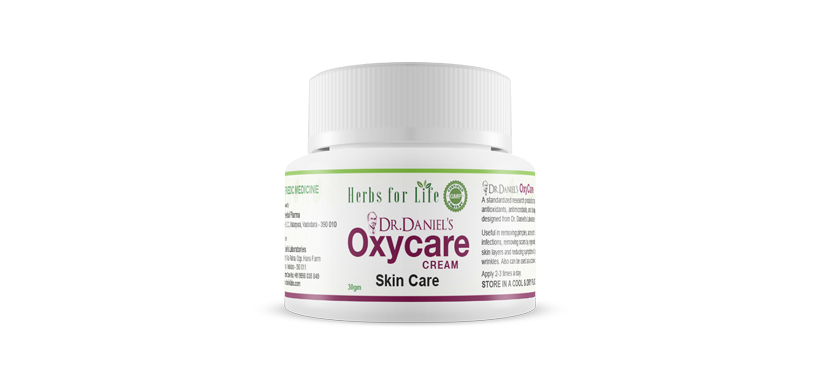Dr. Daniel’s Oxy- Care.
Oxycare, developed by the well-known phytochemist, Prof. M. Daniel and his team in Dr. Daniel’s Laboratories after extensive research, contains well-known herbs rich in antioxidants, anti-inflammatory and antimicrobial agents and blood purifiers. The plants used in Oxycare, their active principles and their clinically proven activities are summarized below.
- Brahmi (Centella asiatica L.) Brahmi contains saponins like brahmoside, thankuniside and indocentelloside which stimulate the production of collagen and thus improves the appearance of aging skin affected by fine lines and wrinkles. Centella asiatica has antiviral, antibacterial, and anti-inflammatory properties. It has traditionally been used as a treatment for skin conditions such as psoriasis, dermatitis and minor burns. This plant is able to heal wounds and burns because of its ability to increase the blood supply to the affected area, elevate the level of antioxidants in the wound, and encourage the production of fibroblasts, the cells that synthesize collagen. Its collagen-boosting and anti-inflammatory properties indicate that Centella asiatica can diminish the appearance of stretch marks and keloid scars. It strengthens the walls of veins and capillaries, thus increase the supply of blood to the skin making it a useful treatment for varicose veins and venous insufficiency. By regulating the excessive production of collagen it prevents excessive scar formation in surgical wounds and also effective in removing scars (Gohil et al., 2010). Centella is a very powerful antioxidant and stimulates the body to manufacture catalase, a powerful anti-aging antioxidant. It is also a powerful skin regenerative agent and works very well in skin repair and rejuvenation.
- Rakthachandan (Pterocarpus santalinus L.f. ) This plant contains quinones like santalin A & B and lignans savinin and calocedrin. All these compounds are excellent antioxidants and strongly antiinflammatory. Rakthachandan is well-known for its use in removing scars, preventing pimples and other infections and for a fairer skin. It thins blood and strengthens capillary walls ensuring a good supply of blood in the skin.
- Garmalo (Cassia fistula Linn.- Bark) The bark is rich in antioxidant flavonols, proanthocyanidins and anthraquinones. It is proved to be a highly potent antibacterial agent (Aneja and co-workers, 2011). It is a valuable anti-inflammatory agent too. It is used to treat eczema, leprosy, itching and other chronic skin diseases.
- Karanj chaal (Pongamia pinnata L. – Bk.) Stem bark contains complex flavonoids like chromenoflavone and demethoxy kanugin. All these compounds are highly antimicrobial compounds. The plant is used in leprosy and an effective remedy for all types of skin diseases like scabies, eczema, leucoderma and ulcers.
- Kuvadio (Cassia tora Linn.) Kuvadio is rich in glycosides of anthraquinones such as cassiamide, rhein, emodin, aloe emodin etc and brassinosteroids. The seeds are exceeding useful in treating eczema, ringworm, psoriasis, ulcers, and other parasitic skin diseases. The flavonoids and quinones prevent and heal infections caused by Staphylococcus, Trichophyton and many parasitic fungi. They are also the best antioxidants in nature and are blood thinners. Brassinosteroids help the skin heal faster.
Triethanolamine stearate, the cream base used in Oxycare, itself is antimicrobial in nature and used as a medicine in various ear diseases and infections in USA. It is one of the best emulsifiers and because it can bind both polar and non-polar regions of the skin, it will penetrate the skin deeper, carrying with it all the polar and non-polar compounds of Oxycare to the best possible effect.
Oxycare is a cream meant to protect and maintain a healthy skin. It can be successfully used for, 1. Preventing and healing pimples; 2. Healing fungal, bacterial and viral infections of skin; 3. Removing stretch marks and keloid scars (need longer time of application to get the desired effect) and 4. Quick healing of wounds, burns and inflammations. It also prevents the signs of aging and help to get a fairer and clear skin.
Caution: Since Oxycare contains a good amount of polyphenolic anti-oxidants, on exposure to air for long time, these compounds may get oxidized to form a reddish brown surface layer. This does not affect the quality of the product. These layers can be remixed with lower layers and used.

